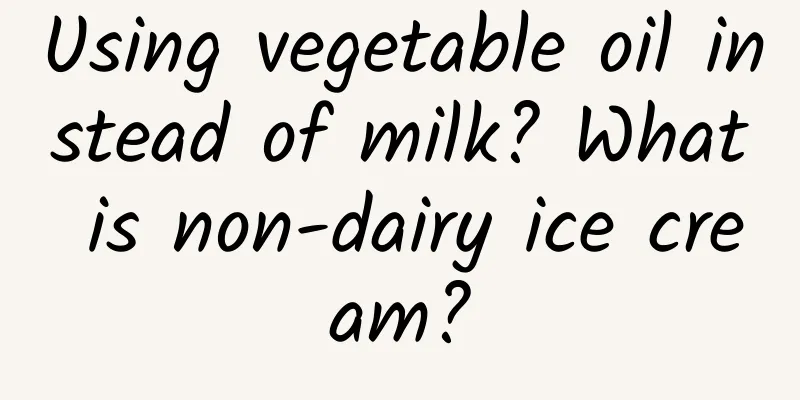Using vegetable oil instead of milk? What is non-dairy ice cream?

|
Some time ago, a certain brand positioned as high-end ice cream was on the hot search list on Weibo several times because of its "double standards". The day before yesterday, the brand company responded to the "double standard" incident and admitted that the ingredients used in its ice creams in China and abroad are different. Experts said that the price difference between the two raw materials is several thousand yuan per ton, which once again sparked heated discussion. The fuse of the whole incident was actually a complaint on Weibo. A blogger compared the ingredients of domestic and foreign versions and found that the domestic version used a large proportion of vegetable oil and only a small amount of milk powder, while the European version was made of pure milk. Image source: Game discount information Weibo As soon as the Weibo post was released, the number of reposts quickly exceeded 10,000, and netizens also began to complain. In response to the doubts, the ice cream brand admitted that its product is a combination non-dairy cream ice cream, and emphasized that non-dairy cream is vegetable fat rather than non-dairy creamer... 01 What is non-dairy creamer? In 1901, German chemist Wilhelm Normann invented hydrogenated fat and obtained a patent. He found that vegetable oil would be converted from liquid to semi-solid or solid after the hydrogenation process. The higher the degree of hydrogenation, the closer it is to solid. Non-dairy creamer is prepared by mixing hydrogenated vegetable oil with casein, syrup, anti-coagulant, mineral salt, emulsifier and other ingredients. Non-dairy creamer has a strong milky flavor, low cost and stable structure, and can be used to prepare almost all milk-flavored desserts and beverages. Hardening (hydrogenation) reaction of olein However, if the hydrogenation of vegetable oils is incomplete, trans fatty acids are easily generated. Studies have shown that trans fatty acids are not easily digested by the human body, which will reduce the content of high-density lipoprotein cholesterol in the blood, increase blood viscosity, and thus increase the risk of heart disease and stroke. Therefore, many consumers equate "non-dairy creamer" with "trans fatty acids", and non-dairy creamer has also been labeled as "harmful to health". Image source: Guokr In fact, with the development of the food industry, the catalysts and processes for oil hydrogenation have been greatly improved, which has greatly reduced the content of trans fatty acids in non-dairy creamer, and it can even be made trans fatty acid-free. Event Information: Tips: According to the national standard, when food ingredients contain or use hydrogenated and/or partially hydrogenated fats during production, the content of trans fatty acids should be indicated in the nutrition information table. If the content of trans fatty acids in 100g or 100ml of food is less than or equal to 0.3g, it can be marked as 0. This explains why some products clearly use hydrogenated oils and trans fatty acids but are labeled as 0. Even if the packaging shows that the trans fatty acids are 0, it does not mean that there are none at all. Image source: Foodie Research Institute 02 Aren't ice cream and popsicles the same thing? When you go to a supermarket and open the freezer, you can see all kinds of cold drinks, which may be ice cream, popsicles, or popsicles. How can you tell them apart? If you go by the name, it is easy to be misled by "capricious" merchants. For example, a famous brand of popsicles in Harbin is actually ice cream. Ice cream that calls itself a popsicle Source: A flagship store of a certain brand It is difficult to distinguish ice cream from popsicles based on the production process. This is because ice cream and popsicles generally go through the process of "ingredients → sterilization → homogenization → cooling → aging → freezing → packaging → molding". The basic production process of popsicles does not include the three steps of homogenization, aging, and freezing. Homogeneous image source: sohu.com The distinction between these three mainly depends on the national standards. The non-fat milk solids content of ice cream is required to be ≥ 6.0g/100g, the minimum fat content is 5g/100g, and the minimum protein content is 2.2g/100g. There are no requirements for non-fat milk solids in ice cream. The minimum fat content is 1g/100g, and the minimum protein content is 0.4g/100g. The main ingredients of popsicles are water and sugar, and the standard is that the total sugar (calculated as sucrose) should be ≥ 7%. Image source: sohu.com 03 Why is ice cream softer? In terms of ingredients, we can see that ice cream contains components such as milk or dairy products and oil. These can reduce the formation of ice crystals during the homogenization process and make the taste of the ice cream more delicate. Image source: sohu.com There is another more important substance that cannot be seen in the ingredient list, which also plays a key role in the taste of ice cream - it is air. Image source: Reference [6] I don’t know if you have had this experience. The ice cream you bought melted, and after you put it back in the refrigerator, you feel that the taste and texture have greatly deteriorated. The taste and texture of the ice cream deteriorate, on the one hand because the homogeneous structure of the ice cream is destroyed after melting, and the water and oil are separated, and on the other hand because a large amount of air is not mixed in during the refreezing process. Image source: pixabay Air is mainly mixed in during the freezing process. Freezing is to mix the mature mixed base with air and freeze it through the strong stirring of the ice cream machine, so that the product solidifies into a semi-solid state, and obtains an ice cream product with fine and smooth texture, good shape and high expansion rate. In terms of volume, air generally accounts for 30% to 50% of the total volume of ice cream! In theory, the higher the air content in ice cream, the softer it is. However, if there are too many bubbles, the stability of the ice cream will be greatly reduced and it will melt easily. Frozen image source: sohu.com 04 Is ice cream high in calories? Unless it is labeled as low-calorie, most ice creams are high in calories! At low temperatures, people's taste buds become dull, and milk or dairy products contain only a small amount of lactose (which is relatively not very sweet), so to increase the sweetness of ice cream, manufacturers generally add more sugar. Although there are some "0 sugar" ice creams on the market today, they are likely to be 0 sucrose, not truly sugar-free. Zero sucrose ice cream with steviol glycosides and erythritol Image source: A brand flagship store Another source of calories in ice cream is fat, which is also an important factor in its deliciousness. According to the national standard, the fat content of full-fat ice cream must be ≥8.0g/100g, and even for half-fat or non-dairy ice cream, the fat content must be ≥5.0g/100g. The fat content of some ice creams even exceeds 20g/100g. Image source: Science Popularization China Taking crispy ice cream cone as an example, every 100g contains 37.5g of sugar, 16.4g of fat, 3.6g of protein, and a calorie content of at least 307 calories, which is roughly equivalent to the calories in 2 kilograms of chilled watermelon. So friends who want to control their weight, please pay attention. While enjoying delicious food, you must also be wary of the "sweet trap"! References [1] Gu Tingting, Song Huanling, Chou Lingjun. Research progress of oil hydrogenation catalysts[J]. Molecular Catalysis, 2020, 34(3): 242-251. [2] GB28050-2011 General Rules for Nutrition Labelling of Prepackaged Foods [3] GB/T 30590-2014 Classification of Frozen Beverages [4] GB/T 31114-2014 Frozen Drinks Ice Cream [5] GB/T 31119-2014 Frozen Drinks Ice Cream [6] Brian Rohrig. “Ice, Cream... and Chemistry”. ACS ChemMatters Magazine, February 2014. Author: Ji Minghua, PhD, Shanghai Advanced Research Institute, Chinese Academy of Sciences, and Director of Basic Research and Development, Shanghai Qingrui Food Technology Co., Ltd. Editor: Xiao Dingdang, Yi Renbai Acknowledgements: Professor Wang Zhengyuan from Shanghai Center for Disease Control and Prevention provided scientific guidance for this article — END — The copyright of the online pictures belongs to the original author. The article belongs to Shanghai Science and Technology Museum. |
<<: Are Hungarians descendants of the Huns?
>>: Where are all the molybdenum mines in China?
Recommend
Microplastics that may threaten health are already in the air we breathe
Microplastics, as the name suggests, refer to ext...
Tsinghua University teacher Pan Pan's learning motivation
Tsinghua University teacher Pan Pan's introdu...
Men’s and women’s bathrooms are common, but did you know there is a third bathroom?
When taking a child of the opposite sex out alone...
IP account creation丨Master the core of IP operation in 3 dimensions
P account creation丨3 dimensions to master the cor...
Are you sure the name Youyouguan is not meant to be cute?
What would you do if you found out that your room...
Zhihu Operations | Full text of 6,000 words of practical information on how to raise an account and monetize it
As a highly active community website in China, Zh...
A scientific guide to postpartum confinement. Mothers recover quickly and suffer less. Teach you how to have a scientific confinement
A scientific guide to postpartum confinement. Mot...
Dongying website SEO optimization cost price company outsourcing
Dongying website SEO mainly provides you with Don...
Audio of 23 educational methods of famous teachers from Beijing No. 4 Middle School
Audio of 23 educational methods of famous teacher...
Zeekr Auto: In Q3 2024, Zeekr's total revenue reached RMB 18.36 billion, a year-on-year increase of 31%.
Zeekr Auto released its third quarter financial r...
How much does it cost per month to rent a computer room with 1TB bandwidth server?
How much does it cost to rent a computer room wit...
Will CCTV Spring Festival Gala's lonely website live broadcast become mainstream?
The ratings of CCTV's 2015 Spring Festival Ga...
Fuse Clip: Do you know these pseudo-original techniques for SEO?
As an SEOer, how to make the website better inclu...









